A talk by Thầy on Christmas Eve 2013 at the “Still Water Meditation Hall”, Upper Hamlet, Plum Village France
Christmas is always an opportunity for us to meditate on the topic of home, our true home. Buddha did not have a home when he was a young person. Although he was born as a prince and had a great deal of material comfort; although he knew that he will be a king, he did not feel at home. He was unhappy. He left the palace in order to find a home, a true home. Jesus Christ was born a refugee. He was also trying to find his home. In the Gospel Jesus said, “Foxes have dens and birds of the air have nests, but the Son of Man has no place to lay His head” (Luke 9:58). He did not have a home. But both the Buddha and Christ practised, and found their true home.
You are their continuation. You are the continuation of the Buddha. You are the continuation of Jesus Christ. You have to follow their teachings and practise in order to find a true home. Have I got a true home? A true home is a place where you feel comfortable and at ease. You don’t want to go anywhere else anymore. You feel so at home, so at ease. Have you found such a place?
Arriving home in our own body
Many of us have been looking for help. But so far, we have not found it. When you come to Plum Village, you are offered the practice that helps you find home. The practice is very concrete. Home is not exactly located in space and time. Everywhere you go, you can find your true home. That is why in Plum Village, we speak of “I have arrived, I am home”. This is the first fruit of your practice. If you practise well, you can arrive home with every breath and every step. Many of us have been able to realize this. We feel comfortable in our true home. Every breath and every step can bring us to our true home.
If you practise walking meditation or mindful breathing and you have not touched your true home, it’s because you have not done it properly. In principle, every breath can bring you home. Every step can bring you home. You are not looking for home somewhere else, somewhere in the future, but right in the here and the now. Those of us who have practised well enough have found our true home in every breath and every step.
When we practice mindful breathing, we focus our attention on our in-breath and we bring our mind home to our body. Our body may be our first home. We have to try to make our body a home. Are you in conflict with your body? Do you hate your body? Have you made acquaintance with your body? Can you feel at home in your body? Our body is a wonder of life. Every one of us is a flower of the garden of humanity. But perhaps many of us do not know how to take care of the flower of ourselves, of our body. We have lost a lot of our “flowerness”, our beauty, our freshness, because we don’t know how to take care of our body.
The first thing you need to do is to go home and recognize that you have a body. Your body is a wonder. When you spend two hours with your computer, you forget entirely that you have a body. And when your mind is not with your body, you are not really there, alive. In the teaching of the Buddha, you are only alive when your mind and body are together. Your mind becomes an embodied mind. And how to bring your body and mind together? Just breathe in mindfully. When you breathe in mindfully, you bring your mind back home to your body. It takes only two or three seconds. And there, your body and mind are united. The fruit is called the oneness of body and mind, and that can be realized by just one in-breath.
In the here and now there is so many wonders of life. First of all, our body is a wonder of life, and the air we breathe in is a wonder of life, and the rain is a wonder of life, a flower is a wonder of life. Everything surrounding us is a wonder of life. When we go home to our body, we have a chance to recognize all these wonders of life available in the present moment. If we do well, all of these become our true home.
In Plum Village, our brothers and sisters programme a bell of mindfulness in their computer. Every quarter of the hour the bell is invited and they stop working, thinking. They go back to their in-breath and out-breath and they come home to their body. They feel they are there, truly alive. They enjoy mindful breathing at least three times and smile before they continue their work. You may like to do the same. You may download the bell of mindfulness from the Plum Village website and it will remind you to go back to your body from time to time, to be alive again. Life is short.
When you are home in your body, you may notice there is quite a lot of tension and stress in your body. We have been working so hard. You have allowed tension and stress to be accumulated in your body. You have not been kind enough to your body. That kind of awareness was born when you go home to your body. Recognizing the tension and stress in your body, you would like to do something in order to help release the tension, to reduce the amount of pain in your body. And that is possible. The Buddha provided us exercises that help us to release the tension in our body.
The third exercise of mindful breathing is:
Breathing in, I am aware of my body.
Breathing out, I smile to my body.
This is an act of reconciliation with your body. You smile to your body: I am sorry my body, I have been neglecting you. I have allowed stress, tension, pain to accumulate in you, my body. The Buddha was very practical.
Breathing in, I am aware of my body. While you are breathing in, you come home to your body. You recognize that your body is a wonder. And when you breathe out, you smile to your body. Your smile can bring relaxation because smiling is an act of love. In your face there are many hundreds of muscles. When you are angry or worried, your face is tensed, using a few hundreds muscles. But if you know how to smile, you can release the tension in the few hundreds muscles on the face. If you look into the mirror, you find that you look much better.
Sitting in the car you may look into yourself in the little mirror to see whether you are beautiful enough. If you are tensed, you are not beautiful enough. When the other person is driving, you take time to breathe, to relax your body. You smile. That is mindfulness. You don’t need to go to the meditation hall in order to practise mindfulness. Just sitting in your car and enjoy breathing, releasing the tension in your body and enjoying the hills, the trees, what you see through the window. That is the third exercise of mindful breathing offered by the Buddha. Recognizing the body, smiling to the body. Everyday we can enjoy our practice several times.
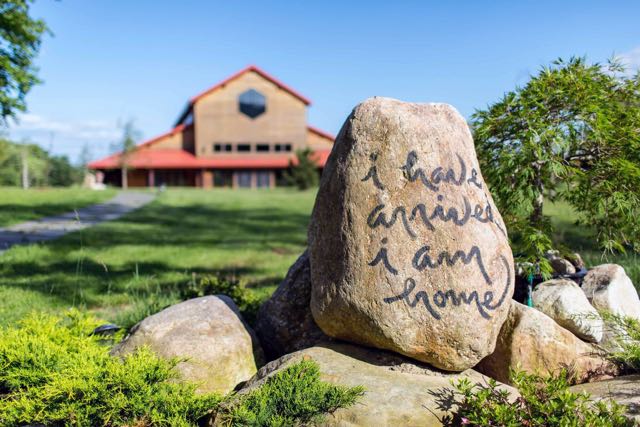
Before your brush your teeth, why don’t you look into yourself in the mirror, smile to yourself, and release the tension? That moment can be a happy moment, that moment can be a wonderful moment. That is the virtue of mindfulness. Mindfulness can create moments of peace, moments of joy, moments of relaxation, moments of happiness. That is the third exercise of mindful breathing. Being aware of your body and smiling to your body. You are so kind to your body. You are making your body part of your true home.
The fourth exercise of mindful breathing described by the Buddha is:
Breathing in, I allow my body to release the tension.
Breathing out, I release the tension in my body.
While you are in a sitting position, you can do that. In sitting meditation, you have to be relaxed. You don’t fight or struggle during sitting meditation. You allow your body to relax. You enjoy every minute of sitting. The first thing you do in sitting meditation is to allow your body to rest and relax, to be in the here and now. You allow your body to recover, to heal itself. With the practice of releasing tension, you give your body a chance to heal. Your body has the power to heal if you allow it to do so. The way to do it is to rest, to release the tension. Remember when you cut your finger, you don’t have to do anything, you just wash it and your body knows how to heal. You have to believe in the power of healing of your own body. We have to authorize our body to heal.
We know that when an animal living in the forest is deeply wounded, she knows what to do. She stops running to look for something to eat or running after an animal. She knows that is not wise to do so. The animal finds a place and just lie down, doing nothing. That animal knows clearly that that is the best way to heal because they don’t have a doctor, they don’t have a drug store, a pharmacy. The animal lies down to heal for a few days and only after the animal is healed, then it stands up and finds something to eat. We human beings, we used to have that kind of wisdom but with the modern age, we have forgotten. We don’t know how to rest anymore. We don’t allow our body to rest, to release tension. We rely entirely on medication. This exercise is very helpful for our modern time. Recognize the body, smile to it, and then release the tension in your body, to help your body to heal.
Healing pain and suffering, creating peace and happiness
There are many reasons why you have abandoned your body. In your body, there may be feelings and emotions that are unpleasant. You have painful feelings and you have painful emotions but you do not know how to handle them. There is a feeling of loneliness, a feeling of despair, and most of us want to cover them up, pretending they are not there. You pretend that the feeling of loneliness, despair, anger and fear are not there. Those of us who do not feel very well inside, in order to forget that, we go to look for something to eat even if we are not hungry at all. We are using food to cover up the suffering inside. And there are those of us who turn on the television or go to the internet to look for something, hoping that with these films, with these music, you can cover up the suffering and you can survive. That is the main characteristic of our civilization now. We don’t know how to handle the suffering inside of us, that is why we try to cover them up with consumption.
The market provides us with all kinds of items so that we can use consumption to run away from ourselves and to cover up the feelings of ill-being in ourselves. Electronic devices sold on the market help us run away from ourselves. That is the direction of our civilization, which is not a good one. We try to run away from ourselves, run away from our family and from nature, which has the power to nourish and to heal us. If we don’t know how to take care of ourselves and how to love ourselves, how can we take care of the people in our family? The practice of mindfulness helps you to reverse this tendency, helps you to go home to yourself and to take care of yourself.
If you know how to take care of your body, if you know how to take care of your feelings and emotions, you will feel more comfortable with your body and your feelings. If you know how to create a feeling of peace and joy, of happiness in your body, in your feelings, you are in the process of creating a true home for yourself. You feel comfortable with your body, your feelings. You are not afraid of your painful feelings because you know how to handle them.
The fifth exercise of mindful breathing offered by the Buddha is to generate a feeling of joy. Every one of us can generate a feeling of joy for our own nourishment. The way is simple enough. When you breathe in mindfully and bring your mind back to your body, when your body and mind are together, you are established in the here and the now. You recognize that you are very lucky. You have so many conditions of happiness that can make you happy right here and right now. You have eyes still in good condition. You only need to open your eyes in order to get in touch with the paradise of forms and colors. There are oysters that live at the depth of the sea. They do not have eyes. They have never seen the blue sky and the stars. They have never seen the ocean and the waves. And you have eyes but you don’t enjoy what you see. Oysters don’t have ears, but you can hear the sound of the wind, the songs of the birds; yet you don’t enjoy them.
Mindfulness helps us to go home to the here and the now and recognize all these wonders of life so that you can create a feeling of joy and a feeling of happiness. That is mindfulness. Mindfulness is a source of joy and happiness because it helps us to recognize the many wonders of life that are available in the here and the now. They help us to recognize the conditions of happiness we have. We don’t need more conditions of happiness. We are lucky enough. We have lungs; good enough for us to enjoy breathing the fresh air. We have a heart that still functions normally. We have strong feet that help us to run and walk. We have so many conditions of happiness; more than enough to be happy. That is why generating the feeling of joy, generating the feeling of happiness is always possible for all practitioners of mindfulness.
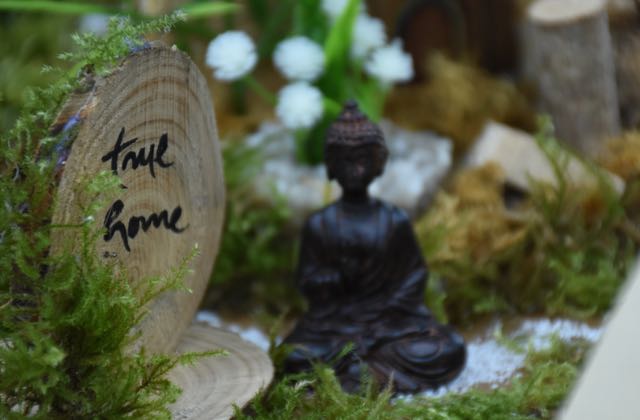
Joy and happiness are a practice. With mindful breathing and mindful walking, you can create a feeling of joy and happiness whenever you want and wherever you want. That is the fifth and the sixth exercise of mindful breathing proposed by the Buddha: generating a feeling of joy, generating a feeling of happiness. That is the art of happiness taught by the Buddha. Each of us should be an artist capable of generating joy and happiness for us and for the people we love.
With the seventh exercise of mindful breathing, the Buddha advised us to recognize the painful feeling, the painful emotion that is arising. A good practitioner should know how to recognize a painful feeling, a painful emotion and not try to run away from it. We have to be there to take care of them and that is the art of suffering. We learn the art of happiness and the art of suffering, of how to suffer. We have discovered that if you know how to suffer, you suffer much less. Much much less than people who do not know how to suffer. The seventh and the eighth exercise of mindful breathing instruct us how to suffer.
With mindfulness, with the practice of mindful breathing and walking we can generate enough energy of mindfulness and we can go home to ourselves without fear. We do not need to be overwhelmed by the painful feeling, painful emotion. With the energy of mindfulness, we can recognize them and smile to them. “Good morning, good afternoon, my pain and sorrow, my fear, I will take care of you.” That is the voice of mindfulness. “Don’t worry, I will take care of you. I am not running away anymore. I know how to take care of you.”
Your pain, your sorrow is a source of energy that is not pleasant. When they come up as a source of energy, you should know how to take care of them. The practice described by the Buddha is to practice mindful breathing and mindful walking to generate the energy of mindfulness. With that energy of mindfulness you recognize the presence of the painful feeling or the painful emotion. We don’t try to cover up this mental formation anymore. You don’t try to run away from it. You are there. You recognize it. My anger, my fear, my loneliness, I will take good care of you. With the energy of mindfulness, we embrace the energy of fear, of anger. It’s like an elder brother holding a younger brother without any violence. You have to learn to do that.
If you are a beginner in the practice, you might borrow the collective energy of mindfulness of your community in order to do that. You sit among us and you practise mindful breathing. You ask the sangha, “Dear brothers, dear sisters in the practice, here is my pain, here is my sorrow, here is my despair. Please help. Please recognize and hold it for me.” So you make good use of the collective energy of mindfulness of your community and embrace it. If you do, you suffer less after just a few minutes of practice. It’s like a mother holding her child. The baby suffers and the mother picks up the baby and holds the baby tenderly in her two arms. The tenderness of the mother begins to penetrate into the body of the baby and the baby begins to suffer less. The energy of mindfulness begins to penetrate into the zone of pain, release the tension and calm the pain.
The seventh and the eighth exercise of mindful breathing is to recognize and calm down the painful feeling and painful emotion. To calm down a painful feeling, to calm down a painful emotion is something you can always do with the practice of mindful breathing or walking. It is possible to survive a strong emotion just by the practice of mindful breathing and mindful walking. With these exercises, you can transform the pain in you.
The energy of community, of sangha
We build our true home slowly, with the help of our brothers and sisters in the practice. The best thing you find when you come to Plum Village is not the meditation hall or the kitchen or the bell tower, but the energy of the sangha. We live here, practise together and create the energy of brotherhood and sisterhood. That collective energy of mindfulness, of joy is the best thing we can offer to you when you come to Plum Village.
We know that in Plum Village, most of the monks and nuns are still very young. We come and build a true home together. None of us have a private bank account. You may be surprised. How can we survive without a bank account? But in fact, none of us have a private bank account, a private house or car. Yet brotherhood and sisterhood are possible with the practice of mindfulness. We share the same future. We live together, we support each other and we listen to each other. We help each other to transform. We have the time to sit together, to eat together, to walk together and work together as brothers and sisters in the community, and that community is our true home.
Jesus found his community and the Buddha also found his sangha. Every one of us has a dream. Martin Lurther King said “I have a dream”. What is that dream? In the teachings of the Buddha there is a source of nutriments called volition. Every one of us should have that kind of food. Every one of us should have a desire, a deep desire. We want to do something with our life. What do I want to do with my life? We sit down, we breathe and we find out what we want to do with our life. The Buddha did have a deep desire to practise and to liberate himself, to help other people suffer less, and to cultivate peace and joy. That was his deepest desire. He was able to realize his desire. He knew that he alone could not do much. That was why he decided to build a community, a sangha. A Buddha without a sangha cannot do much. Jesus had the same insight. He tried to build a sangha. That was the beginning of the Christian community, with twelve people, then thirty people.
The Buddha began with five friends who had practised with him, and from that he built a sangha of several thousands of monks and nuns and laypeople. The Buddha spent a lot of his time building a sangha, building a community. After the Buddha passed away, his sangha, his community continued his work to help people to suffer less. Jesus Christ did the same to build a sangha, but he did not have as much time as the Buddha to build a sangha.
When I met Martin Lurther King in Chicago for the first time in 1966, we did discuss about sangha. I met him again in Geneva and we also discussed about sangha building. He agreed that without a sangha, we could not go very far. At that time Martin Lurther King used the term “beloved community”, a community that has brotherhood and sisterhood, joy, mindfulness and peace that can nourish us. That is the best thing we can offer to the people who come.
Sangha building is a very important part of the practice. If you are a friend of the Buddha, of Jesus, if you are the continuation of the Buddha, of Jesus, you have to build a sangha wherever you are to continue the practice. In every big city, there are practice communities with affiliation to Plum Village. Sangha building is something every one of us takes into our heart. We know that it is a very important part of our practice.
What do I want to do with my life?
What do I want to do with my life? That is a good question. We should have a strong aspiration, a strong desire. If you have that desire, that strong aspiration, you have a lot of energy. You want to realize that aspiration. With that powerful source of energy you are not afraid of overcoming the difficulties in front of you. You need that kind of energy of volition, aspiration.
The year is ending. We want to ask ourselves: What is the thing I want to do with my life?
As a couple, you may have to sit together to ask each other: “Darling, what is your dream? What is the deepest desire in your life? May I support you?” What we want is not just material comfort and affective comfort. We want to do something very good with our life. That is why we have to sit down and ask each other. If we don’t communicate like that, we will not understand each other. Our happiness will not be strong enough. For a couple, this is very important. You sit down and you ask: “Darling, do you have a dream you want to realize? Do we share the same kind of dream?” Jesus had a dream. The Buddha also had a dream. They wanted to realize that in their daily life. Martin Lurther King had that famous speech “I have a dream”.
A young man may sit down with his father and ask his father, “Daddy, when you were young, did you have a dream? What was your dream? What did you want to do with your life? Were you able to realize that? Can I help you? Can I continue your dream?” That kind of talk is very important. That connects you with your father. We are not just talking about daily concerns. We are talking about our ultimate concerns. Each of us should have our ultimate concerns. What do I want to do with my life? Father and son should discuss with each other. If you have not been able to realize your dream, you son may help realize it for you. In doing so, there will be a connection, a good communication between father and son. The quality of the relationship will be improved. From now to the beginning of next year, you may think about this. You may write to or call the other person and discuss about this, about the ultimate concerns and not just daily concerns. That is something we can reflect on this day, Christmas Day.
Dear friends, dear brothers and sisters, we came together on this day of Christmas in order to have an opportunity to look deeply again into our life and to have a clearer idea of our true home. We should know what we really want. We should devote our time and energy to build our true home. Without our true home, we cannot realize our dream. Merry Christmas.


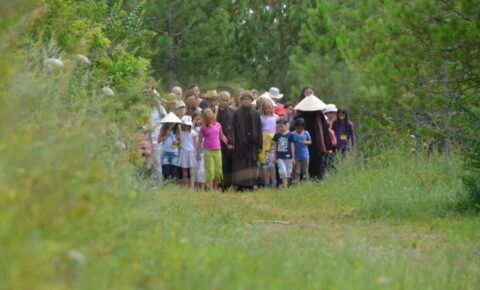
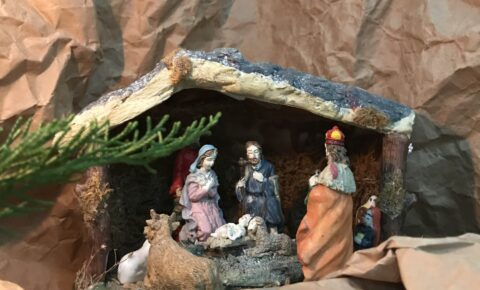
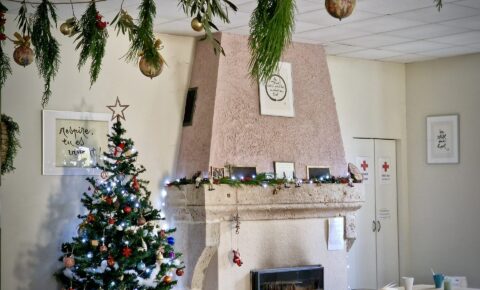
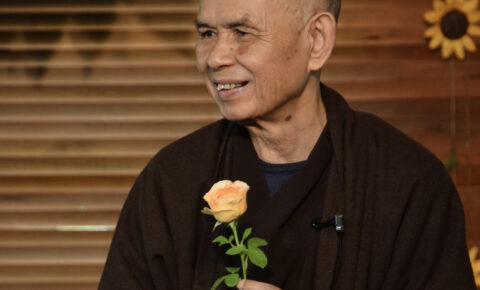
Share Your Reflections